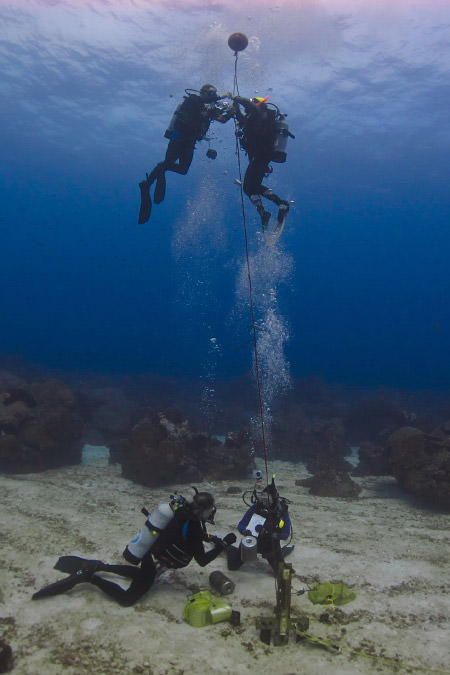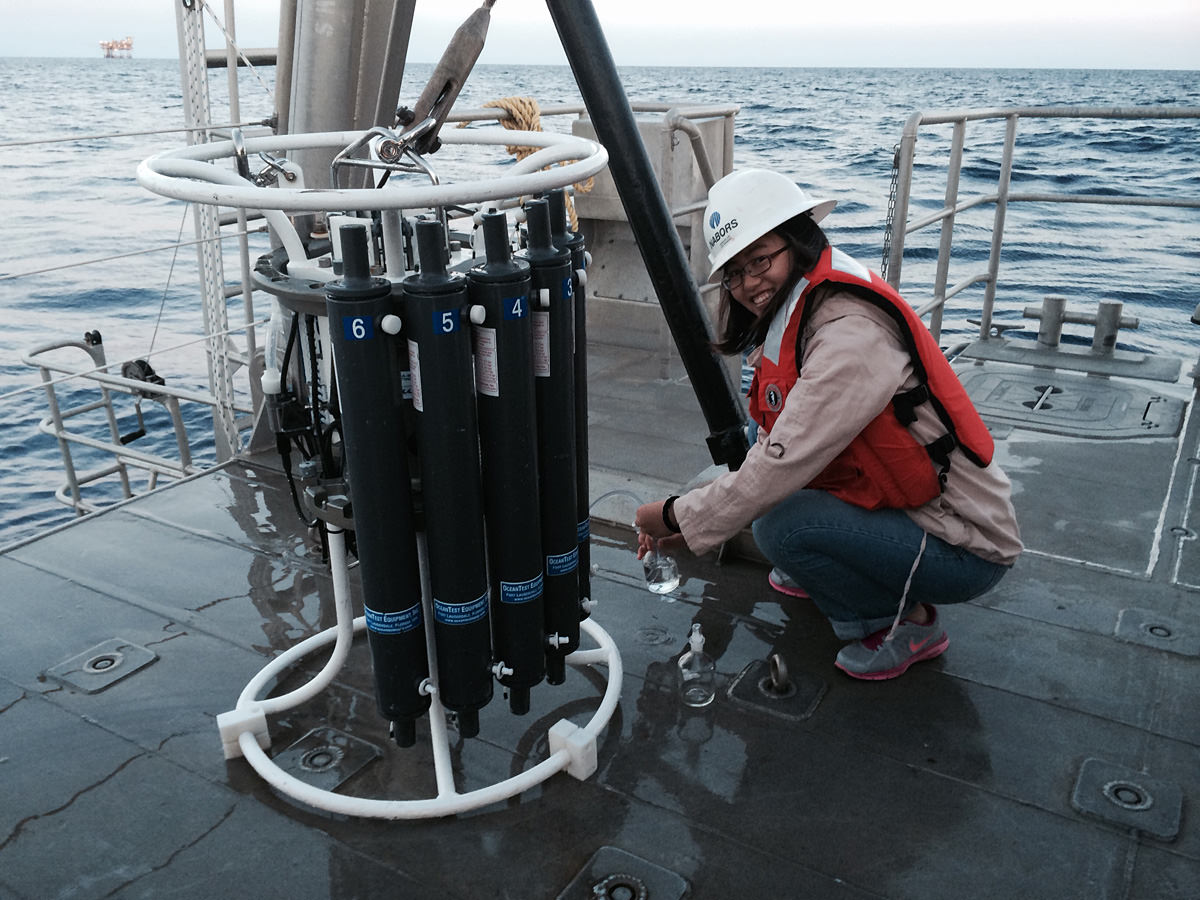Water Quality
Flower Garden Banks

Why is it a concern?
Water quality can be impacted by the presence of contaminants (i.e. pesticides, hydrocarbons and heavy metals), excessive sedimentation, and elevated nutrient loads. The most significant potential sources of contaminants at Flower Garden Banks National Marine Sanctuary (FGBNMS) include pollutants associated with oil spills, untreated sewage, and pollutants associated with offshore liquefied natural gas production. Occasionally land based pollutants reach the area, particularly following large rain events associated with storms and hurricanes.
Impact from an oil spill or other hydrocarbon release is an ongoing concern. Threats to the sanctuary can result from discharges from leaking pipelines and damage to platforms (particularly resulting from natural events, such as hurricanes, or dragging of anchors). Ongoing operational effluents from oil and gas facilities include drilling lubricants, produced water (water separated from the oil or gas after it is pumped from the reservoir), and operational discharges (e.g., sewage, graywater, and deck wash).
The discharge of untreated sewage from vessels is not allowed within the sanctuary. However, the discharge from a U.S. Coast Guard-approved marine sanitation device is currently allowed. Marine sanitation devices are only required to remove suspended solids and treat for potential human pathogens. Nutrients and other pollutants are not removed by these systems. Other vessel discharges include "graywater" from showers and galleys, deck runoff, and incidental release of petrochemicals from engine use.
The quality of coastal waters of the northern Gulf of Mexico is in decline due to pollutants associated with the discharge of major river systems (such as the Mississippi and Atchafalaya), general coastal runoff throughout the region, and habitat alteration (e.g., salt water intrusions in marshes). Predominant current patterns direct much of this water away from the sanctuary, but minor changes in circulation patterns could bring contaminated water and land-based runoff to the sanctuary.
Recent observations of surrounding reefs and banks have documented algal blooms – Sargassum at Geyer and McGrail Banks, and Codium at Bright Bank. These blooms appear to be competing for space and light for coral resources. It is unknown what the driver is for these blooms, but they may be an indication of degrading water quality conditions.
Overview of Research
Quarterly water sampling and analysis is conducted at the sanctuary as part of the long-term monitoring projects at all banks within the sanctuary.
Research and monitoring of contaminants in FGBNMS has in the past included pre- and post-drilling surveys (using chemical analysis of sediments) to evaluate the fate and effects of their discharges on the sensitive biological assemblages inhabiting the nearby banks.
Monitoring of hydrocarbons was implemented using Semi-Permeable Membrane Devices (SPMD)s as part of the response plan for the Deepwater Horizon Blowout.
| Project Name | PI and contacts | Links |
|---|---|---|
East and West Flower Garden Banks Long-Term Monitoring |
Dr. Michelle Johnston, FGBNMS |
|
Stetson Bank Long Term Monitoring |
Marissa Nuttall, FGBNMS |
Science Needs and Questions
- Is "graywater" harmful to FGBNMS resources?
- What is the fate of corals and mesophotic communities after exposure to dispersants?
- What are the current levels of heavy metals in key biota in FGBNMS?
- What do the isotopic signatures of key biota in FGBNMS indicate regarding coastal influences?
- What are the dynamics of the coastal influences on FGBNMS resources?
- What are the water quality conditions in locations identified for sanctuary expansion?
- What is the cause, and potential impact of the algae blooms occurring at McGrail, Geyer, and Bright Banks? Are these blooms occurring elsewhere?
Education and Outreach Material
Gulf of Mexico Watershed Activity (878kb pdf)
- An activity highlighting the large size of the Gulf of Mexico watershed (with answer key). Great practice in identifying and labeling the 48 contiguous states.

References
Office of National Marine Sanctuaries. 2008. Flower Garden Banks National Marine Sanctuary Condition Report 2008. U.S. Department of Commerce, National Oceanic and Atmospheric Administration, Office of National Marine Sanctuaries, Silver Spring, MD. 49 pp.
Continental Shelf Assoc., Inc. 1996. Long-term monitoring at the East and West Flower Garden Banks. OCS Study MMS 96-0046. U.S. Department of the Interior, Minerals Management Service, Gulf of Mexico OCS Region, New Orleans, Louisiana. 77 pp. + app
Dokken, Q.R., I.R. MacDonald, J.W. Tunnell, Jr., C.R. Beaver, G.S. Boland, and D.K. Hagman. 1999. Long-term monitoring at the East and West Flower Garden Banks, 1996-1997. U.S. Department of the Interior, Minerals Management Service, Gulf of Mexico OCS Region, New Orleans, Louisiana. OCS Study MMS99-0005.
Dokken, Q.R., I.R. MacDonald, J.W. Tunnell, Jr., T. Wade, K. Withers, S.J. Dilworth, T.W. Bates, C.R. Beaver, and C.M. Rigaud. 2003. Long-term monitoring at the East and West Flower Garden Banks, 1998-2001: Final Report. U.S. Department of the Interior, Minerals Management Service, Gulf of Mexico OCS Region, New Orleans, Louisiana. OCS Study MMS 2003-031. 90 pp.
Gittings, S.R. and G.S. Boland. 1991. Long-term monitoring on the Flower Garden Banks: study design and field methods. pp. 24-28 In: Proc.: Eleventh Ann. Gulf of Mexico Information Transfer Meeting. U.S. Department of the Interior, Minerals Management Service, New Orleans, Louisiana. Contract No. 14-35-0001-30499. OCS Study MMS-91-0040. 524 pp.
Gittings, S.R., G.S. Boland, K.J.P. Deslarzes, D.K. Hagman and B.S. Holland. 1992b. Long-term monitoring at the East and West Flower Garden Banks. Final Rept. OCS Study/MMS 92-006. U.S. Department of the Interior, Minerals Management Service, Gulf of Mexico OCS Regional Office, New Orleans, Louisiana. 206 pp.
Johnston, Michelle A., M.F. Nuttall, R.J. Eckert, J.A. Embesi, N.C. Slowey, E.L. Hickerson, and G.P. Schmahl. 2013. Long-term monitoring at the East and West Flower Garden Banks National Marine Sanctuary, 2009–2010, volume 2: appendices. U.S. Dept. of Interior, Bureau of Ocean Energy Management, Gulf of Mexico OCS Region, New Orleans, Louisiana. OCS Study BOEM 2013-215. 362 pp.
Johnston, M.A., M.F. Nuttall, R.J. Eckert, J.A. Embesi, N.C. Slowey, E.L. Hickerson, and G.P. Schmahl. 2015. Long-term monitoring at East and West Flower Garden Banks National Marine Sanctuary, 2011–2012, volume 1: technical report. U.S. Dept. of Interior, Bureau of Ocean Energy Management, Gulf of Mexico OCS Region, New Orleans, Louisiana. OCS Study BOEM 2015-027. 194 p.
Precht W.F., R.B. Aronson, K.J.P. Deslarzes, M.L. Robbart, T.J.T. Murdoch, A. Gelber, D. Evans, B. Gearhart and B. Zimmer. 2010. Long-term monitoring at the East and West Flower Garden Banks, 2004-2005; Final report. U.S. Department of the Interior, Minerals Management Service, Gulf of Mexico OCS Region, New Orleans, Louisiana. OCS Study MMS.

